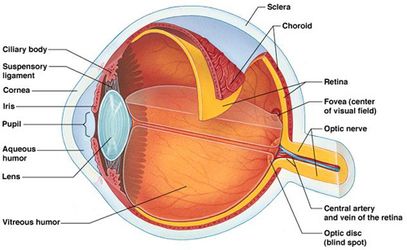Serving Patients in Wilmington with Retinal Diseases: Retinal Detachment, Vascular Disease, Floaters, Flashers
 Retinal diseases encompass a variety of conditions. While some are common and easy to treat, others prove more challenging to diagnose and treat. The retina plays a vital role in the ability to see. As light enters the pupil, the cornea and lens invert and focus the light and project it onto the back of the eye. Located at the back of the eye is the retina, which is composed of seven layers of tissue. The retina takes the light and converts it into a neural signal that travels along the optic nerve to your brain. The result is the crisp, clear image of what you see. When the retina becomes diseased, it can have a devastating effect on sight. Retinal diseases include:
Retinal diseases encompass a variety of conditions. While some are common and easy to treat, others prove more challenging to diagnose and treat. The retina plays a vital role in the ability to see. As light enters the pupil, the cornea and lens invert and focus the light and project it onto the back of the eye. Located at the back of the eye is the retina, which is composed of seven layers of tissue. The retina takes the light and converts it into a neural signal that travels along the optic nerve to your brain. The result is the crisp, clear image of what you see. When the retina becomes diseased, it can have a devastating effect on sight. Retinal diseases include:
- Macular holes
- Macular pucker / epiretinal membrane
- Retinal tears / Retinal detachment
- Flashes and floaters
- Retinal vein or artery occlusion
- Uveitis

Our experienced retinal surgeons, Dr. Paula Ko and Dr. Carolyn Glazer-Hockstein diagnose and treat these retinal diseases in our Wilmington, Delaware office. Contact us to schedule an appointment.
Macular Hole
Macular holes form in the part of the retinal tissue called the macula. The macula, responsible for your central vision, is attached to the vitreous gel that makes up the center of the eye. Over time, this vitreous gel starts to detach from the retina, which causes a hole to form in the macula. As a result, central vision is distorted or lost.
As soon as you notice a change in your central vision, you should contact Dr. Ko or Dr. Glazer-Hockstein. If a macular hole is the cause of your vision loss, early treatment may be the only way to save or restore your vision.
Vitrectomy surgery, now possible without sutures, may be used to repair the hole. With a success rate of 90%, the vitrectomy procedure uses a gas bubble to apply pressure to the macula so that it can begin to heal. You will need to keep your face down for two weeks after the procedure in order for the surgery to be successful.
Macular Pucker
A macular pucker, or epiretinal membrane, consists of a slow-growing scar tissue-like membrane that appears on the macula. Macular puckers can be associated with advanced age, with diabetic retinopathy or with retinal detachment. However, most macular puckers are idiopathic, that is, from unknown causes. As the membrane grows, the macula begins to swell, causing your vision to become blurry.
Mild cases of macular pucker are left untreated. When vision loss is severely affected, the damaged membrane may be removed by sutureless vitrectomy surgery performed to heal and smooth the macula.
Retinal Tears / Retinal Detachment
Retinal tears / retinal detachment is a serious condition in which the inner vitreous fluid shrinks causing a tear in the retina. A retinal tear allows the fluid to seep under the retina and causes it to detach from its underlying layer. When this happens, patients begin to lose peripheral vision (like a shade is closing), leading to permanent vision loss if left untreated.
As with any serious condition, early treatment provides the best chances to save your sight. A common early symptom is the sudden onset of flashes and floaters in one eye.
There are a variety of treatment options available to repair retinal tears or detachments that can restore or preserve your eyesight. Treatment often depends on whether the retina is just torn or if it has detached as well. In cases where the retina is torn, laser photocoagulation (heat) or cryopexy (cold) can repair the hole by creating scar tissue to adhere the retina to the tissue below. Photocoagulation uses a laser to create tiny burns on the peripheral surface of the retina, which leaves your central vision intact. The cryopexy procedure takes the opposite approach and freezes the area surrounding the hole.
When the retina has detached from its underlying layer, procedures such as laser surgery, pneumatic retinopexy or scleral buckling are performed to repair the damage:
- In pneumatic retinopexy, cryopexy will be performed to freeze the tear and encourage the growth of scar tissue. Then a gas bubble is injected into the vitreous gel fluid in the eye. Over the period of a few weeks, the bubble creates enough pressure on the retina that it reattaches to its underlying layer. This procedure is typically performed in the office.
- During the scleral buckling procedure, a piece of silicone will be attached to the sclera of the eye, beneath the tears in the retina. This causes an indent that repairs the detached retina. This surgery is performed in an operating room.
A successful outcome of the surgery depends on the severity of damage to the retinal tissue. Less severe damage yields a greater chance of restoring and/or preserving vision. If you experience symptoms of a retinal tear or retinal detachment, such as flashes and floaters, contact Dr Ko or Dr. Glazer-Hockstein, retinal specialists at Eye Physicians and Surgeons, P.A. in Wilmington, Delaware, for an immediate evaluation.
Flashes and Floaters
Flashes and floaters can either be harmless or signal a serious problem in your eye. Flashes are tiny flashes of light that appear in the peripheral vision. They are caused when the fluid inside your eye rubs against the retina. Floaters are little clumps of gel that float in the fluid inside your eye and cause a shadow against the retina, making it appear as if little shapes are floating across your line of vision. As we age, the vitreous gel fluid that forms the inner part of the eye begins to shrink. This causes it to start pulling away from the retina. Floaters are the byproduct of this vitreous separation, and can signal either the natural aging process or a much more serious problem, such as a retinal detachment.
If you begin to see floaters or flashes, especially if you are over the age of 45 and/or are very nearsighted, you should make an appointment to see Dr. Ko or Dr. Glazer-Hockstein at our office in Wilmington. They will do a thorough eye exam to see if the floaters and flashes are a harmless nuisance or signal a more serious problem. Treatment depends on the your particular condition.
Retinal Vein or Artery Occlusion
Retinal arteries carry nourishing blood supply to the retina of the eye, while retinal veins circulate this blood back to the heart. As with veins and arteries in the rest of the body, blockages can occur, causing a disruption to the blood flow and creating serious complications including loss of vision or stroke. If this occurs in the veins, it is called retinal vein occlusion; in the arteries, it is called retinal artery occlusion. Both comprise a larger condition known as retinal vascular disease. Our skilled retinal surgeons, Dr. Ko and Dr. Glazer-Hockstein, diagnose and treat retinal vascular disease at our office in Delaware.
Retinal Vein Occlusion
Retinal vein occlusion mainly occurs in older people and is caused by a blood clot in the vein. It is also caused by retinal arteries applying pressure to a retinal vein due to blood clot, diabetes, glaucoma, hypertension, or atherosclerosis—the hardening of the arteries.
As with many of the other eye conditions, the first symptom is often blurry vision in all or part of your eye. Your retina will be examined through a series of test that may include dilating the pupil to provide a more complete view of the retina, fluorescein angiography to study the retinal circulation, and optical coherence tomography (OCT), the latest technology to image the layers of the retina.
Laser treatment, as well as the injection of special new medications, are available for the management of retinal vein occlusion. The outcome often varies, though many patients regain their sight. Blood clots can be prevented with a low-fat diet and exercise. If you have diabetes, it is important to keep it under control to prevent clots from forming.
Retinal Artery Occlusion
Retinal artery occlusion is caused by blood clots, fat, or plaque that gets caught in the arteries. Clots often travel from other parts of the body. Their ability to travel makes them dangerous; if a retinal artery occlusion travels to the brain, it can cause a stroke. When they occur in a retinal artery, less oxygen-rich blood is able to nourish your eye, leading to partial vision loss, the extent of which depends on the location of the blockage.
Occurring most often in older people, certain other factors present a higher risk for retinal artery occlusion including diabetes, hypertension, atrial fibrillation (a problem with the rhythm of the heart), carotid artery disease, or heart valve disease.
The first symptom of retinal artery occlusion is an acute and total loss of vision in one eye. The tests to spot retinal artery occlusion are similar to that of retinal vein occlusion; that is, your retina will be thoroughly examined to spot the clot. Dr. Ko or Dr. Glazer-Hockstein may also do other tests to check your blood pressure or cholesterol.
Unfortunately, there is a chance that those with a retinal artery occlusion may not regain their sight. However, these clots may be prevented with a low-fat diet, exercise, and weight loss.
Uveitis
The uvea of the eye is the middle, pigmented layer of the eye that supplies blood to the retina. Uveitis is inflammation and swelling that occurs in the uvea. Uveitis is caused by certain injuries to the eye, infection, or autoimmune disorders. It can also happen with no foreseeable cause.
Treatment often includes dilating eye drops, steroid eye drops, or antibiotics (if the uveitis is associated with another body-wide infection). Uveitis can disappear within a few weeks or last longer. The longer it lasts, the higher the risk for permanent vision damage.
Laser Surgery
Laser surgery is often an option for those with conditions affecting the retina such as diabetic retinopathy, retinal vein occlusions, age-related macular degeneration, or retinal detachment. In retinal vein occlusions, laser surgery can reduce swelling or eliminate new obstructive blood vessels. For retinal detachments, laser surgery is used to fuse the retina to its underlying layer.
Prior to the laser treatment, the eye will be numbed with eye drops. These eye drops also serve to dilate the pupil, giving the laser a clear path to the damaged tissue. Treatment lasts between 10 and 30 minutes, depending on the specific procedure. Typically a painless procedure, laser treatment provides a quick and easy option for those with damaged eye tissue.
Learn More About Retinal Diseases: Detachment, Retinal Vascular Disease, Macular Puckers
Contact Eye Physicians and Surgeons, P.A. in Wilmington, Delaware to make an appointment to diagnose any retinal conditions you may have. Our retinal surgeons, Dr. Ko and Dr. Glazer-Hockstein have the expertise to diagnose and treat all retinal diseases.

